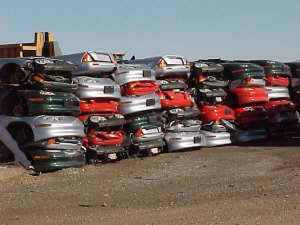California fails to curb its oil addiction, no luck with alternative fuels thus far
California fails to curb its oil addiction, no luck with alternative fuels thus far
mongabay.com
August 2, 2006
California has failed in its efforts to curb its addiction to oil says an article in today’s issue of The Wall Street Journal
“For a quarter century, California has pursued petroleum-free transportation more doggedly than any other place in the U.S. It has tried to jump-start alternative fuels ranging from methanol to natural gas to electricity to hydrogen. None has hit the road in any significant way. Today, the state that is the world’s sixth-largest economy finds itself in the same spot as most of the planet: With $75-a-barrel oil, and increasing concern about the role fossil fuels are playing in global warming, 99% of its cars and trucks still run on petroleum products.”
 EV1s crushed by General Motors shortly after production. Image courtesy of Sony Pictures Classics. |
The article, by Jeffrey Ball, says that California has not found convenient, reliable, or affordable replacements for gasoline. Infrastructure costs, political motives, and economic choices have thus far doomed efforts to wean drivers and industry away from traditional fossil fuels.
California tried to launch its alternative-fuel drive following the 1979 global oil shock using a combination of incentives for such fuels and regulations mandating cleaner conventional fuels and internal-combustion engines, but according to Ball, “the market hasn’t responded the way California intended.”
“The oil and auto industries got the state to kill or water down the alternative-fuel mandates, arguing that making the technologies viable would require big public subsidies — something most Californians didn’t support. Meanwhile, the industries made their conventional products clean enough to meet the state’s pollution limits.”
“The upshot: The alternative-fuel push has helped scrub California’s air, but it has done so by forcing improvements in fossil fuels and the cars that burn them. It hasn’t curbed California’s oil consumption, because it hasn’t meaningfully deployed alternative fuels.”
Ball notes that only one gas station in the entire state sells E85, a blend of 15% gasoline and 85% methanol.
The article mentions electric vehicles, which were briefly driven in the state, before being quashed by lack of consumer demand and the car’s manufacturer, GM. The story of the electric car is featured in “Who Killed the Electric Car?” a documentary released earlier this year and currently playing in theatres.
A new generation of electric car debuts later this year with the Tesla Roadster, an $80,000 electric sports car built by silicon valley’s first car company.
Subscribers can read the WSJ article at
This article contains quotes from “Reality Check How California Failed in Efforts To Curb Its Addiction to Oil” by Jefferey Ball, which appears in the August 2, 2006 of The Wall Street Journal